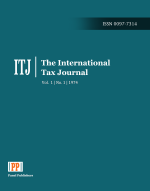The causative relationship among energy efficiency, renewable energy consumption, and carbon dioxide emissions utilizing the VAR model: A case study of Tunisia from 1991 to 2022
Keywords:
Energy intensity, consumption of renewable energy, renewable energy sources, carbon dioxide emissionsAbstract
This study investigates the causal relationship among energy efficiency, renewable energy consumption, and carbon dioxide emissions in Algeria from 1991 to 2022, employing the Variable Autoregressive Regression (VAR) model. The findings indicated a causal association between energy efficiency and carbon dioxide emissions, although no causal relationship exists among the other factors. Consequently, energy efficiency pertains to the mitigation or augmentation of carbon dioxide emissions, indicating that fewer natural resources are utilized to produce equivalent energy, resulting in a decrease in carbon dioxide emissions.
Downloads
References
1. Agency, I. R. (2023). World Energy Transitions Outlook 2023. the EU: International Renewable Energy Agency.
2. Al-Tuwairi, N. S., & Muhammad Ali, a.-H. (2023). Using the VAR model to measure the impact of public investment on private investment in Libya during the period (1990-2020). Academic Research Journal, 26, 44-35. Récupéré sur https://lam-journal.ly/index.php/jar/article/view/507/396
3. Bocca, R., & Muqsit , A. (2022). Fostering Effective Energy Transition 2022. the World Economic Forum.
4. Bridge, G., Stewart , B., Stefan , B., Michael , B., Ed , B., Harriet , B., & Gordon , W. (2018). Energy and Society A Critical Perspective (éd. 1st Edition). London: Routledge. doi:https://doi.org/10.4324/9781351019026
5. Chaired, R. R. (2006, 03 30). Vector Autoregressive Models for. washington. Récupéré sur https://faculty.washington.edu/ezivot/econ584/notes/varModels.pdf
6. He, P. (2023, November ). Energy-saving, economic and environmental benefits analysis of cool roofs and green roofs for retail buildings in America. Applied and Computational Engineering, 25(1), 242-253. doi:10.54254/2755-2721/25/20230771
7. Kamal, A., Sami , G.-G., & Muammer , K. (2019, August ). Revaluing the costs and benefits of energy efficiency: A systematic review. Energy Research & Social Science, 54, 68-84. doi:https://doi.org/10.1016/j.erss.2019.03.012
8. Khadidja, B., & Brahimi, B. (،2020, 10 18). The relationship between Energy consumption and the CO2 emission and Economic growth in Germany by using the vector auto regression during (1979-2017). Journal of Strategy and Development, 10(5), 132-152. Récupéré sur https://asjp.cerist.dz/en/downArticle/276/10/5/130469
9. Knight, S. (2017). LED bulbs reduced carbon dioxide emissions by more than half a billion tons in 2017. USA: TECHSPOT. Récupéré sur https://www.techspot.com/news/72489-led-bulbs-reduced-carbon-dioxide-emissions-more-than.html?
10. Naqqar, O., & Munther , A. (2012). Using VAR models in forecasting and studying the causal relationship between GDP and gross capital formation in Syria. Damascus University Faculty of Economics and Law., 28(2), 339-360. Récupéré sur chrome-extension://efaidnbmnnnibpcajpcglclefindmkaj/https://www.damascusuniversity.edu.sy/mag/law/images/stories/2-2012/a/337-360.pdf
11. Roufechaei, K. M., Abu Hassan , A., & Amin , A. (2014). Energy-efficient design for sustainable housing development. Journal of Cleaner Production, 380-388.
12. World, A. (2025). Energy Efficiency Redefined: The Environmental Benefits of LED Lighting. Houston. USA: APLED World. Récupéré sur https://www.apledworld.com/energy-efficiency-redefined-the-environmental-benefits-of-led-lighting]/
Downloads
Published
How to Cite
Issue
Section
License
Copyright (c) 2025 The International tax journal

This work is licensed under a Creative Commons Attribution-NonCommercial-NoDerivatives 4.0 International License.








